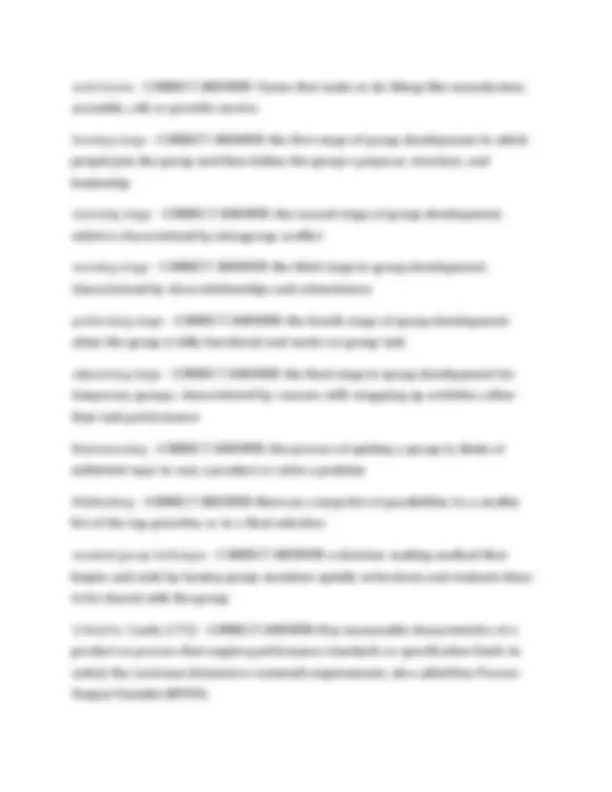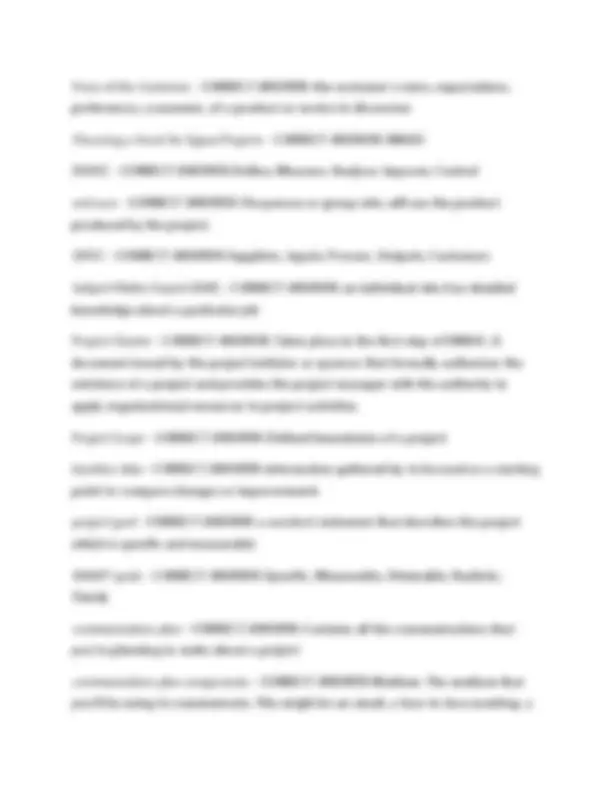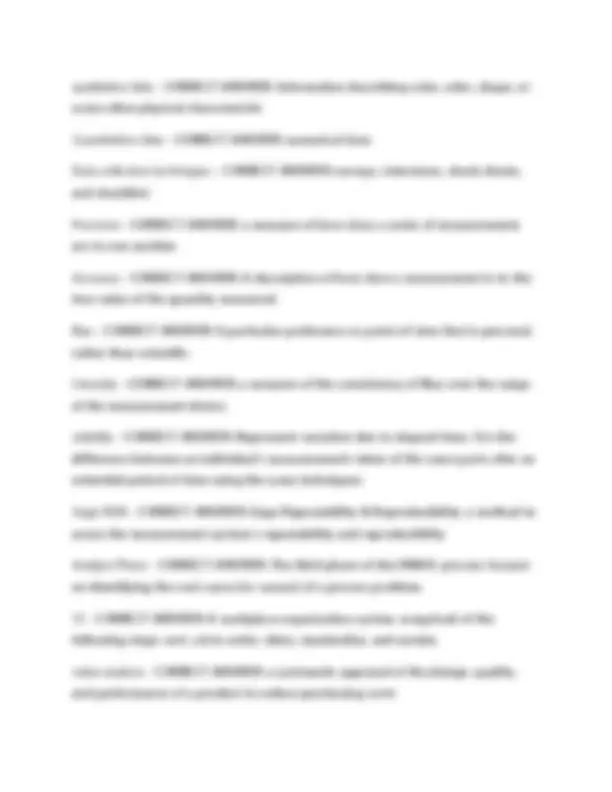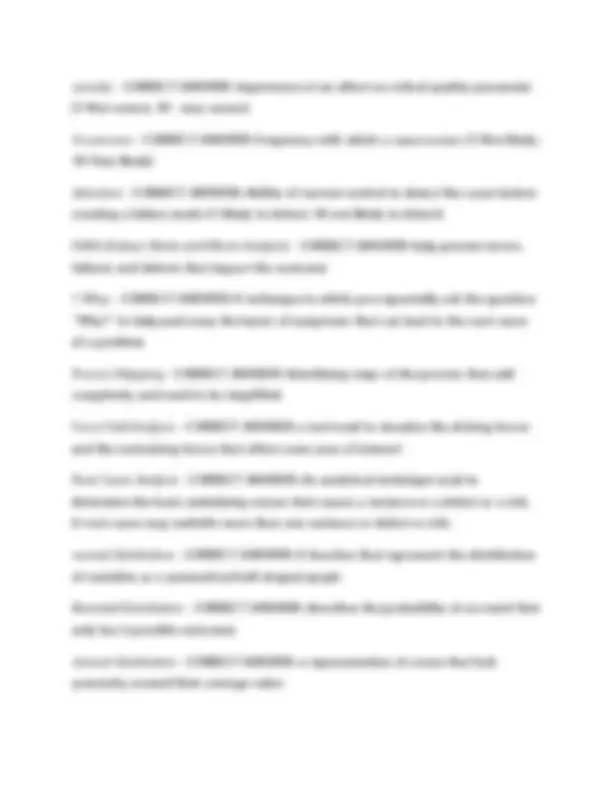








Study with the several resources on Docsity

Earn points by helping other students or get them with a premium plan


Prepare for your exams
Study with the several resources on Docsity

Earn points to download
Earn points by helping other students or get them with a premium plan
Community
Ask the community for help and clear up your study doubts
Discover the best universities in your country according to Docsity users
Free resources
Download our free guides on studying techniques, anxiety management strategies, and thesis advice from Docsity tutors
The purpose of Six Sigma - CORRECT ANSWER-Reduce variation Six Sigma Black Belts - CORRECT ANSWER-Leads problem-solving projects. Trains and coaches project teams.
Typology: Exams
1 / 12

This page cannot be seen from the preview
Don't miss anything!







The purpose of Six Sigma - CORRECT ANSWER-Reduce variation Six Sigma Black Belts - CORRECT ANSWER-Leads problem-solving projects. Trains and coaches project teams. Six Sigma Yellow Belt - CORRECT ANSWER-Participates as a project team member. Reviews process improvements that support the project. Six Sigma Green Belts - CORRECT ANSWER-Assists with data collection and analysis for Black Belt projects. Leads Green Belt projects or teams. Six Sigma Master Black Belt - CORRECT ANSWER-Trains and coaches Black Belts and Green Belts. Functions more at the Six Sigma program level by developing key metrics and the strategic direction. Acts as an organization's Six Sigma technologist and internal consultant. Champion - CORRECT ANSWER-Translate the company's vision, mission, goals and metrics to create an organizational deployment plan and identify individual projects. Identify resources and remove roadblocks. 7 quality control tools - CORRECT ANSWER-Cause-and-effect diagram (also called Ishikawa diagram or fishbone diagram) Check sheet Control chart Histogram Pareto chart Scatter diagram Stratification
cause and effect diagram - CORRECT ANSWER-fishbone diagram: identifies many possible causes for an effect or problem. It can be used to structure a brainstorming session. It immediately sorts ideas into useful categories. Check Sheet - CORRECT ANSWER-a structured, prepared form for collecting and analyzing data. Control Chart - CORRECT ANSWER-scatterplot: a statistical chart of time-ordered values of a sample statistic Histogram - CORRECT ANSWER-A graph of vertical bars representing the frequency distribution of a set of data. Pareto Chart - CORRECT ANSWER-a bar graph whose bars are drawn in decreasing order of frequency or relative frequency scatter diagram - CORRECT ANSWER-a graph that shows the degree and direction of relationship between two variables Stratification - CORRECT ANSWER-The act of sorting data, people, and objects into distinct groups or layers DPU - CORRECT ANSWER-defects per unit or (total number of defects)/(total number of units) DPMO - CORRECT ANSWER-defects per million opportunities or DPU*million Rolled Throughput Yield (RTY) - CORRECT ANSWER-The probability that a process with more than one step will produce a defect free unit: YRT = YTP at step 1 * YTP at step 2 * YTP at step 3 cycle time - CORRECT ANSWER-the time needed to complete a process
work teams - CORRECT ANSWER-Teams that make or do things like manufacture, assemble, sell, or provide service. forming stage - CORRECT ANSWER-the first stage of group development in which people join the group and then define the group's purpose, structure, and leadership storming stage - CORRECT ANSWER-the second stage of group development, which is characterized by intragroup conflict norming stage - CORRECT ANSWER-the third stage in group development, characterized by close relationships and cohesiveness performing stage - CORRECT ANSWER-the fourth stage of group development when the group is fully functional and works on group task adjourning stage - CORRECT ANSWER-the final stage in group development for temporary groups, characterized by concern with wrapping up activities rather than task performance Brainstorming - CORRECT ANSWER-the process of getting a group to think of unlimited ways to vary a product or solve a problem Multivoting - CORRECT ANSWER-Narrows a large list of possibilities to a smaller list of the top priorities or to a final selection nominal group technique - CORRECT ANSWER-a decision-making method that begins and ends by having group members quietly write down and evaluate ideas to be shared with the group Critical to Quality (CTQ) - CORRECT ANSWER-Key measurable characteristics of a product or process that require performance standards or specification limits to satisfy the customer (internal or external) requirements; also called Key Process Output Variable (KPOV).
Voice of the Customer - CORRECT ANSWER-the customer's voice, expectations, preferences, comments, of a product or service in discussion Choosing a Great Six Sigma Projects - CORRECT ANSWER-DMAIC DMAIC - CORRECT ANSWER-Define, Measure, Analyze, Improve, Control end user - CORRECT ANSWER-The person or group who will use the product produced by the project. SIPOC - CORRECT ANSWER-Suppliers, Inputs, Process, Outputs, Customers Subject Matter Expert (SME) - CORRECT ANSWER-an individual who has detailed knowledge about a particular job Project Charter - CORRECT ANSWER-Takes place in the first step of DMAIC: A document issued by the project initiator or sponsor that formally authorizes the existence of a project and provides the project manager with the authority to apply organizational resources to project activities. Project Scope - CORRECT ANSWER-Defined boundaries of a project baseline data - CORRECT ANSWER-information gathered by to be used as a starting point to compare changes or improvements project goal - CORRECT ANSWER-a succinct statement that describes the project which is specific and measurable SMART goals - CORRECT ANSWER-Specific, Measurable, Attainable, Realistic, Timely communication plan - CORRECT ANSWER-Contains all the communications that you're planning to make about a project communication plan components - CORRECT ANSWER-Medium: The medium that you'll be using to communicate. This might be an email, a face-to-face meeting, a
tree diagram - CORRECT ANSWER-A diagram used to show the total number of possible outcomes Phase Review - CORRECT ANSWER-A step in the new product development process where approval is required to proceed to the next step Define Phase - CORRECT ANSWER-The first phase of the DMAIC method which involves defining the problem or opportunity, determining the voice of the customer/customer requirements, and outlining the project purpose/scope. Measure Phase - CORRECT ANSWER-A phase in the six sigma design-measure- analyze - improve-control process during which current performance is evaluated. mean - CORRECT ANSWER-average Median - CORRECT ANSWER-Middle number Mode - CORRECT ANSWER-most frequently occurring value range - CORRECT ANSWER-the difference between the highest and lowest scores in a distribution standard deviation - CORRECT ANSWER-a computed measure of how much scores vary around the mean score Variance - CORRECT ANSWER-standard deviation squared Data Collection - CORRECT ANSWER-The process of acquiring existing information or developing new information. How to create a data collection plan? - CORRECT ANSWER-Identify the Questions we want to answer, What kind of data is available, What form does that data come in, How Much Data Do We Need, How are we going to measure this data, to Sample or Not to Sample, How will we display the data?
qualitative data - CORRECT ANSWER-Information describing color, odor, shape, or some other physical characteristic Quantitative data - CORRECT ANSWER-numerical data Data collection techniques - CORRECT ANSWER-surveys, interviews, check sheets, and checklists Precision - CORRECT ANSWER-a measure of how close a series of measurements are to one another Accuracy - CORRECT ANSWER-A description of how close a measurement is to the true value of the quantity measured. Bias - CORRECT ANSWER-A particular preference or point of view that is personal, rather than scientific. Linearity - CORRECT ANSWER-a measure of the consistency of Bias over the range of the measurement device stability - CORRECT ANSWER-Represents variation due to elapsed time. It is the difference between an individual's measurements taken of the same parts after an extended period of time using the same techniques Gage R&R - CORRECT ANSWER-Gage Repeatability & Reproducibility: a method to assess the measurement system's repeatability and reproducibility Analyze Phase - CORRECT ANSWER-The third phase of the DMAIC process focuses on identifying the root cause (or causes) of a process problem. 5S - CORRECT ANSWER-A workplace organization system comprised of the following steps: sort, set in order, shine, standardize, and sustain. value analysis - CORRECT ANSWER-a systematic appraisal of the design, quality, and performance of a product to reduce purchasing costs
bimodal distribution - CORRECT ANSWER-two peaks Common Cause Variation - CORRECT ANSWER-Natural or expected variation in a process Common cause variation examples - CORRECT ANSWER-Time changes or delays, inappropriate procedures, Special Cause Variation - CORRECT ANSWER-unexpected glitches that affect a process. Special Cause Variation examples - CORRECT ANSWER-machine malfunctions, computer crashes, cut power Correlation - CORRECT ANSWER-A measure of the extent to which two factors vary together, and thus of how well either factor predicts the other. no correlation - CORRECT ANSWER-There is no relationship between data sets. negative correlation - CORRECT ANSWER-as one variable increases, the other decreases positive correlation - CORRECT ANSWER-A correlation where as one variable increases, the other also increases, or as one decreases so does the other. Both variables move in the same direction. Regression - CORRECT ANSWER-a measure of the relation between the mean value of one variable (e.g. output) and corresponding values of other variables (e.g. time and cost). regression analysis - CORRECT ANSWER-Regression analysis is a powerful statistical method that allows you to examine the relationship between two or more variables of interest
hypothesis testing - CORRECT ANSWER-make and test an educated guess about a problem/solution null hypothesis - CORRECT ANSWER-a statement or idea that can be falsified, or proved wrong alternative hypothesis - CORRECT ANSWER-the hypothesis that a proposed result is true for the population Type 1 error - CORRECT ANSWER-Rejecting null hypothesis when it is true type 2 error - CORRECT ANSWER-failing to reject a false null hypothesis p-value - CORRECT ANSWER-The probability level which forms basis for deciding if results are statistically significant (not due to chance). Power of a hypothesis test - CORRECT ANSWER-the probability of rejecting the null hypothesis when the null is false Improve Phase - CORRECT ANSWER-The fourth phase of the DMAIC process that focuses on identifying opportunities and implementing solutions. Kaizen - CORRECT ANSWER-continuous improvement, performed on a part-time basis Kaizen Blitz - CORRECT ANSWER-an intense and rapid improvement process in which a team or a department throws all its resources into an improvement project over a short time period PDCA - CORRECT ANSWER-a continuous improvement model of plan, do, check, act cost-benefit analysis - CORRECT ANSWER-weighs the real costs of a potential solution under consideration against the potential benefits of the solution (improve phase)